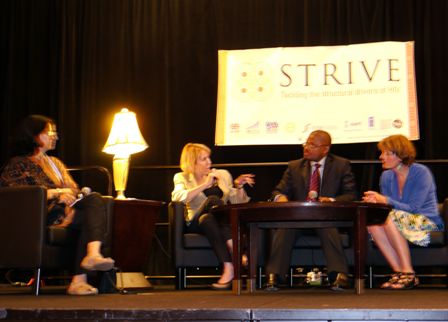"Luxury or Necessity? Structural Factors in a Biomedical Era". This topic drew a larger-than-expected crowd to the consortium's launch during the International AIDS Conference in Washington, DC.
It was far from the first mention of structural factors. When Hillary Clinton opened the July 2012 conference, the US Secretary of State emphasised the importance of stigma and other elements of the social environment. "When key groups [sex workers and injecting drug users] are marginalised, the virus spreads rapidly within these groups and also into the lower-risk general population. Humans might discriminate, but viruses do not," said Clinton. She went on - as many speakers did - to identify the mutual benefits to both HIV and development of addressing gender and other inequalities. "In sub-Saharan Africa, women account for 60% of those living with HIV, and they want access to adequate healthcare."
So, with STRIVE's agenda on everyone's lips, Research Director Dr Saidi Kapiga kicked off the launch by sketching the broad outlines of the international research partnership, now entering its first year of full implementation.
Chief Executive Dr Lori Heise then transported the audience to the birthplace of public health, the Broad Street pump in 1850s London. When John Snow removed the pump handle to prevent the spread of cholera, he founded not only the discipline of epidemiology but also the practice of structural intervention. Heise's presentation detailed the evidence and arguments for investigating structural causes of vulnerability to HIV.
Reviewing the evidence on key structural interventions in practice, Research Director Dr Charlotte Watts made an unusual comparison between HIV prevention strategies: medical male circumcision on one hand and, on the other, programmes to keep adolescent girls in schools. The Zomba trial - investigating the effect of cash transfers to keep girls in school on HIV prevalence - found a 64% reduction in HIV risk. That's on a par, Watts pointed out, with the best results for medical male circumcision, a measure that has garnered headlines and millions in implementation funding.
The invited panel then took their seats in a cosy chat-show scene. Professor Helen Rees, OBE, from STRIVE partner in South Africa, WRHI, chaired the conversation between guests:
- Professor Shalini Bharat,Chairperson of the Centre for Health and Social Sciences, Tata Institute of Social Sciences, India, and a member of STRIVE's advisory group
- Busani Ngcaweni, Deputy Director General in the Office of the Deputy President of South Africa
- Dr Marijke Wijnroks, Netherlands Government Ambassador for Sexual and Reproductive Health and HIV
The discussion demonstrated the great strength of the STRIVE consortium: close attention to rigorous research plus big-picture analysis of the implications of the findings. Professor Bharat drew attention to gender inequality as a primary driver fuelling the epidemic, along with economic inequities and stigma. At the policy level, panelists agreed, it is crucial that governments focus prevention efforts on high-risk populations including sex workers, men who have sex with men and injecting drug users, with Mr Ngcaweni acknowledging that this continues to be controversial in some contexts. In conclusion, Dr Wijnroks gave her opinion of the topic. Everyone agrees that progress depends on removing structural barriers to HIV prevention, she said. The real question is how to do that - and with what funding and what political will.
Co-host and STRIVE partner ICRW tweeted on the proceedings and media reports were published as far from Washington, DC as Asia.
For photographs of STRIVE partners at AIDS 2012, see the gallery - click on an individual image to scroll through.
For presentations by researchers, modellers and economists from the STRIVE's host group, Social and Mathematical Epidemiology, at the London School of Hygiene and Tropical Medicine, see SaME's page of links.




